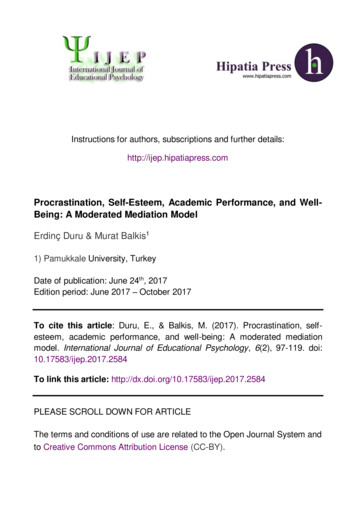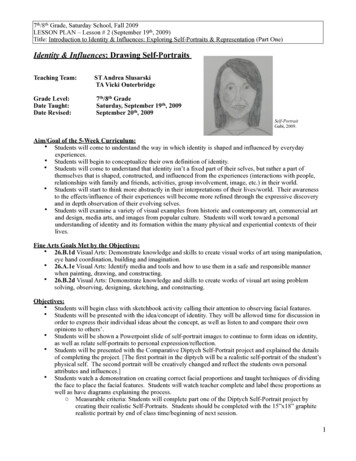
Transcription
IDENTITY ANDSELF ESTEEM
This book is one of seven constituting“On My Own Two Feet”Educational Resource Materialsfor use in Substance Abuse EducationWorksheets may be copied for educational purposesfree and without special permission.Permission for additional use may be obtained fromDept. of Education and Science, Marlborough St.,Dublin 1, IrelandAn Roinn Oideachais agus Eolaíochta, Department of Education and ScienceAn Roinn Sláinte agus Leanaí, Department of Health and ChildrenMater Dei Counselling CentreISBN No. 086387 044 9 2nd Edition 19972
IDENTITY ANDSELF ESTEEM3
CONTENTSINTRODUCTION 5GRID OUTLINING MATERIALS 10LESSON 1 GETTING TO KNOW YOU 14LESSON 2 LEARNING TO LISTEN 16LESSON 3 GROUP BUILDING 19LESSON 4 I.D. CARDS 22LESSON 5 THIS IS ME 27LESSON 6 LIFELINE 30LESSON 7 CHANGES 35LESSON 8 MY HOPES 40LESSON 9 FAMILY CREST 43LESSON 10 THAT’S LIFE! 47LESSON 11 SUNSHINE 51LESSON 12 OPTION A FEEDBACK CIRCLE 55LESSON 12 OPTION B POSITIVE POSTERS 58LESSON 13 THINK POSITIVE 61LESSON 14 SEX ROLES 64LESSON 15 NOBODY’S PERFECT 68LESSON 16 ACCEPTING POSITIVES 754
INTRODUCTIONSELF ESTEEM is a concept used to convey the positive regard you have for yourself. It isbased on your judgement of your own worth and importance. One’s self-picture or selfimage is influenced by one’s interaction with others. It reflects the messages received andtaken in about oneself from ‘significant others’ whether these messages are explicit or implicit,verbal or non-verbal, valid or invalid. It is important to realise that small children tend to acceptwithout question most of what they’re told about themselves. At that stage of development, childrenare unable to discriminate between valid and invalid criticism and believe many of the negativemessages they receive.If people can gain an understanding of how they can build and support their own self worth it willhelp considerably in the primary prevention of substance abuse.This understanding will alsosupport preventive work in relation to many personal and interpersonal problems. Teachers whopiloted these materials emphasised the need for repeated attention to this area of self esteem,especially for students with a poor self image.One stage in developing self esteem is receiving validation for just being yourself. In order todevelop a sense of well being in oneself and to go out into the world with confidence, to try out whatone has learned, it is important that the child or young person receives certain messages from others.Parents are the ideal source of these messages, but any significant adult can give the child thesemessages – grandparents, other relations, child-minders, youth leaders and teachers.Children need to know that they are loved and wanted. They need to experience consistency andtrust and they need to have clear limits set for them.It is natural to want to be accepted, but if your view of yourself depends excessively on how othersrate you, it will be very hard to act autonomously, to make a stand against peer pressure, to takerisks, to defend a position and especially to handle criticism and rejection. A goal of identityeducation must be to help people understand how they have come to have their current self imageand to appreciate their own uniqueness and value even when other don’t. This work on identity istherefore at the heart of healthy growth and development and will contribute to many areas of thechild’s life.5
LOW SELF ESTEEMWhile low self esteem my not have a major part to play in the early stages of drug use, especially inrelation to legal drugs, it is an important factor in the progression to abuse of drugs. Any effectivework done in building self esteem in school can contribute in a very important way to the preventionof drug abuse in later life. It is crucial for responsible behaviour. Students with low self esteem arevery vulnerable in interpersonal relationships; they assume that others do not like them and they feelrelatively isolated and lonely. Rosenberg (1965) found adolescents with low self esteem to beawkward in social relationships; they maintained a defensive front; they indulged in boasting with aconsequent fear of exposure; they were unable to maintain relationships in a consistent way; and theyfelt misunderstood and suspicious of others.Low self esteem is manifested in Extreme concern with what other people think. A lack of autonomy and individuality. Boasting or wanting to impress in order to disguise low self esteem.Low self esteem comes from such growing up experiences as: Absence of affection, encouragement, challenge. Conditional love and acceptance. Criticism, ridicule, sarcasm, cynicism. Physical beatings and abuse. Absence of recognition and praise for achievements. Uniqueness not being reinforced.It is reinforced within certain kinds of family and school systems.Troubled systems which foster low self esteem are characterised by: Criticism for being different. Punishment for mistakes. Distorted communication. Inflexible rules.6
HIGH SELF ESTEEMWhat does high self esteem do for you?Having a strong rooted sense of self worth enables one to cope with both failure and success, tosurvive mistakes, disappointments and even rejection by others. It is built through the experience ofbeing accepted by others but does not depend excessively on it.A person with high self esteem feels good about all aspects of him/herself and accepts his/herlimitations. People with high self esteem show less anxiety and less stress under failure. They aremore socially effective, confident and ambitious. They look and feel good, they are effective andproductive and they respond to other people and themselves in healthy, positive ways. They makebetter relationships, are less defensive, are able to handle criticism and don’t brag and boast so much.People with self confidence and high self esteem are less likely to abuse drugs.HOW IS HIGH SELF ESTEEM DEVELOPED?Coopersmith (1967) related it to:1.Almost TOTAL acceptance of the child by his/her parents i.e. unconditional love.2.Clearly defined and enforced limits of behaviour.3.Respect for and latitude for individual action within defined limits.4.High parental self esteem.SCHOOL SUPPORT FOR THE DEVELOPMENT OF SELF ESTEEMHigh self esteem is very important in all areas of school performance. If the school wishes tocompensate as far as possible for some of the effects of society’s shortcomings in its treatment ofchildren, then we must ask how the school enhances or erodes the self esteem of students.This means that we must evaluate the signals sent to students about themselves. A sense ofbelonging is very unlikely to occur in a system which defines one as useless or as a troublemaker.Such policy areas as whether to opt for streaming, banding or mixed ability, and whether to withdraw7
students for extra help or commit resources to team-teaching for weaker classes can have seriousimplications for how students define themselves.We must also find ways of building up self respect in those we teach and of raising awareness amongall members of the school about how supportive, sensitive and positive behaviour towards each othercan nurture self esteem.In nurturing systems: individual differences are appreciated; mistakes are not only tolerated but are seen as an opportunity for learning; communication is open; rules are flexible.These features of nurturing systems apply, of course, just as much to the staff room as to theclassroom.Indeed, staff development work which includes attention to developing positiveinterpersonal relationships, building up teacher’s own self esteem and which offers opportunities toteachers for support and renewal, will all contribute to the development of a climate supportive ofeach individual in the school.ISSUES TO CONSIDER IN USING IDENTITY AND SELF ESTEEM MATERIALSIn this section, attention is paid to defining who we are as individuals. An important part of this isour sense of family identity. With changing patterns in the ‘traditional’ family constellation ofmother, father and children, it is inevitable that there will be children in differing situations. It isimportant to be sensitive to the particular background of students and to recognise and acknowledgea number of possible family scenarios.In addition the issue of adoption can be a difficult one for adolescents. The teacher needs to be alertto other situations, which differ from the ‘norm’, and to help students feel that they are part of aworld in which there is a variety of personal situations.OVERVIEW OF THE MATERIALThe materials in this section focus on building a strong sense of one’s identity or sense of self and onexploring how self esteem can be nurtured and developed.8
The section begins in Lessons 1, 2 and 3 with some basic group building and listening exercises. Anability to listen is a sound basis for all healthy and supportive relationships and merits more attentionthan given here, but excellent materials are available in some of the programmes referenced in theresource section of the School Handbook.Exercises 4, 5, 6, 7, 8 and 9 help students explore who they are – their likes, dislikes and opinions,how they see themselves, the changes they are experiencing, their hopes for the future and theimportance of family identity as part of their individual identity.Lessons 10 and 11 involve looking at how we build this picture of ourselves through the messageswe’ve received from others.We then go on in Lessons 12, 13 and 16 to provide experiences of positive feedback and techniquesfor self support.There are two exercises on body image and sex roles, as body image is crucial to one’s overall imageand self esteem and because during the pilot phase it emerged as a major preoccupation for somestudents. Society’s expectation of how we ‘should’ be is examined in both Lessons 14 and 15.LAYOUT OF THE MATERIALSThe GridA grid outlining the materials in this book is provided overleaf. The lessons identified, as corematerial should be given priority in planning a programme. Lessons identified as optional orreinforcer may be used to meet the needs of particular groups for a different approach or to revisit atopic.The lesson plans are a guide. Individual teachers are encouraged to adapt them to take account of theparticular needs of their class and their own teaching style.In most lesson plans additional material is provided. Pages labelled ‘Handout’ are to be copied fordistribution to students. Other material is for teacher reference. References for additional materialson the area addressed in this book can be found in the School Handbook.9
IDENTITY AND SELF ESTEEM – AT A GLANCESTAGETITLETOPICMETHODOLOGYLINKS WITHCORE ORREINFORCERSUITABLEFOREstablishingsafety andbelonging ina group1 Getting toKnow YouIntroductions.Ground rules.Game.Work in pairs.Large group.ID 2 ‘Learning to Listen’.CoreAG2 Learning toListenListening skills.Pairs.Class discussion.ID 1 ‘Getting to Know You’.ID 3 ‘Group Building’.CoreAG3 GroupBuildingDrawing up a groupcontract.Teacher input.Brainstorming.CoreJAG4 I.D. CardsBuilding a sense ofpersonal identity.Games.Small groups.Class discussionCoreJLV5 This is MeBuilding a sense ofpersonal identity.Collage, small groups.Class discussion.ID 4 ‘I.D. Cards’.ReinforcerJAG6 LifelineBuilding of personalidentity and grouptrust.Drawing a lifeline.Small groups.Class discussion.ID 4 ‘I.D. Cards’.ID 5 ‘This is Me’.ID 10 ‘That’s Life!’CoreAG7 ChangesGrowth anddevelopment inadolescenceGuided fantasy.Drawing.Pairs/fours.Class discussion.ID 6 ‘Lifeline’.CoreJAG8 My HopesHopes and dreamsfor the future.Collage.Pairs.Display.Class discussion.ID 5 ‘This Is Me’.ReinforcerJLV9 Family CrestDeveloping personalidentity throughfamily identity.Drawing/worksheet.Small groups.Class ��Who Am I?’J Junior Cycle, S Senior Cycle, V Verbal, LV Less Verbal, AG All GroupsIn General exercises for JLV will work with older, brighter groups, but those marked S or V will not work with younger or less verbal groups10DRUGCONTENT
IDENTITY AND SELF ESTEEM – AT A GLANCESTAGETITLETOPICMETHODOLOGYLINKS WITHCORE ORREINFORCERSUITABLEFORTheinfluence ofpositive andnegativemessageson one’s selfpicture10 That’s Life!Effects of positiveand negativemessages.Picture story.Colouring.Small groups.Brainstorming.AC 15 ‘Criticism’.CoreJAG11 SunshineEffects of positiveand negativemessages.Guided fantasy/music.Worksheets.Small groups.CoreSelect one ofthe following:11, 12A or 12BAG12 Option A:FeedbackCircleBuilding self esteemthrough experienceof positive feedback.Receiving positivemessages frommembers of thegroup.Things you can dowhen feeling down.CoreSelect one ofthe following:11, 12A or 12BCoreSelect one ofthe following:11, 12A or 12BOptionalAG12 Option B:PositivepostersDrawing.Feedback circle.Large group discussion.Pairs.Small groups.Drawing/poster work.Class discussion.ID 10 ‘That’s Life!’FE 9 ‘Feeling Thermometer’.FE 10 ‘Expressing yourFeelings’.AC 14 ‘Positive Self-Talk’.ID 10 ‘That’s Life!’ID 11 ‘Sunshine’AGCoreAGSelf SupportStrategies13 ThinkPositiveStereotypingand BodyImage14 Sex RolesExploringstereotypes.15 Nobody’sPerfect (2parts)Body Image.16 AcceptingPositivesAccepting positivethings aboutourselvesSelf SupportID 10 ‘That’s Life!’ID 11 ‘Sunshine’AC 14 ‘Positive Self Talk’.AGList positive actions.Write/draw strengths.Thought stopping.Collage.Display.Class discussion orquestionnaire.1) Case study/questionnaire.Small group.Class discussion.2) Worksheet.Small groups.Design an ad.Positive feedback.ID 12A ‘Feedback Circle’.ID 12B ‘Positive Posters’.AC 14 ‘Positive Self Talk’ID 7 ‘Changes’.ID 15 ‘Nobody’s perfect’.ID 12B ‘Positive Posters’.ID 16 ‘Accepting Positives’AC 14 ‘Positive Self Talk’CoreAGGuided fantasy.Small groups.Class discussion.ID 10 ‘That’s Life!’ID 11 ‘Sunshine’ID 12B ‘Positive Posters’.ID 13 ‘Think Positive’.ReinforcerAGJ Junior Cycle, S Senior Cycle, V Verbal, LV Less Verbal, AG All GroupsIn Gene
High self esteem is very important in all areas of school performance. If the school wishes to compensate as far as possible for some of the effects of society’s shortcomings in its treatment of children, then we must ask how the school enhances or erodes the self esteem of students. This means that we must evaluate the signals sent to students about themselves. A sense of belonging is very .










